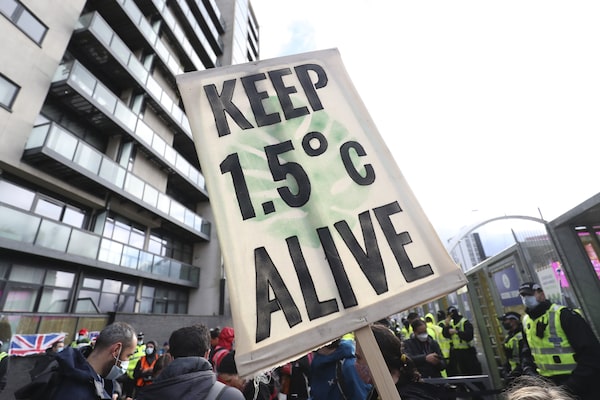
Activists take part in a demonstration outside the COP26 UN climate summit in Glasgow, Scotland, on Nov. 12. To mitigate the climate’s economic impact, we need a rapid transformation, not transition, of our economy, writes Laura Zizzo.Scott Heppell/The Associated Press
Laura Zizzo is chief executive officer and co-founder of Manifest Climate
Climate change action will require companies to walk and chew gum at the same time.
Keeping the global average temperature rise to less than 1.5 C above pre-industrial levels is almost out of reach, as current trajectories have us exceeding a 3 C rise. The COP26 climate conference’s resolutions last week require actionable policy implementation to keep us closer to the goals of the 2015 Paris Agreement.
The world promised to try to hold climate heating to 1.5 C. That goal is nearly dead
COP26 ends with a deal, but coal compromise leaves at-risk countries angry
In the meantime, to mitigate the climate’s economic impact, we need a rapid transformation, not transition, of our economy. It will require us to walk and chew gum at the same time, namely: to rapidly shift to a low-carbon economy while building resiliency to volatile climate and weather conditions.
Corporate strategic plans must move from environmental sustainability to one of overall viability. Companies now need a credible plan for both net zero and increased resilience in order to work with suppliers and customers, who will be dealing with an increasing number of floods, fires and other supply chain disruptions.
Our immediate future requires a transformation not unlike what happened during the Third Industrial Revolution, where billions were spent to digitize. We went from typewriters to the iPhone in 25 years. In hindsight, any hesitation to digitize at the time seems foolish.
It’s been 15 years since An Inconvenient Truth opened our eyes to climate change, so why are businesses hesitant today? To say that our economy is too dependent on fossil fuels is akin to saying we depended too much on paper and fax machines to embrace digital. Today there is inadequate infrastructure to support electric vehicles yet we built transmission towers in record time to accommodate mobile phones. A main difference between now and then is the entrenched power advocating that people not transform. And that influence is waning in the face of stark realities.
Now that we are looking at a vastly transformed world by 2050, businesses will have to double down on strategic planning for the climate transformation. Where to begin?
Will the COP26 summit make a difference? Only if this momentum turns into action
The lack of transparency and a clear definition and measurement of sustainable investment remains a significant problem. There are benchmarks for sales, net promoter scores and competitive rankings, but few companies have one for climate to know where they stand against their competitors and how far they are from where they need to be.
We need to move from a “sustainability” view of climate as an environmental, social and governance metric toward a transformational economic view where the emphasis is on core business risks and the opportunities that are inherent in the transformation we are seeing. The focus on merely counting greenhouse gas emissions and setting reduction targets loses sight of the strategic forest for the tactical trees.
To remain viable, businesses will need to make all decisions through a climate lens, considering how each decision contributes to a net-zero and more resilient future state. Developing a new product will need a climate lens. Opening a new factory will need a climate lens. Looking for a new supplier will require a climate lens.
There are few, if any, corporate decisions that will not require a climate lens. This lens will not be uniform across all economic sectors. For example, a bank might be thinking of risks within a loan book versus a manufacturer about supply chain and distribution channels.
While we need to rapidly phase out fossil fuels, we will also need policies and incentives for high-emitting companies to invest their capital in technologies to transform rather than immediately abandon current sources of economic activity. At the same time, governments and regulators should prevent high-emitting companies from diluting capital by increasing dividends or share buybacks in much the same way banks were prevented from the same activity during the pandemic.
One of the difficulties is that climate is without clear signals so making smart climate decisions today is like trying to use the internet in the early 1990s; there was no common language. We need a global taxonomy for climate now to help companies tell their climate story in a universal way. Models exist but the search for comprehension, certainty and perfection is preventing much needed progress.
As the climate changes so will the taxonomy. Get on with it. Government policies need to provide incentives and penalties to facilitate quicker action.
Governments alone cannot continue to bear the brunt of climate action just as they didn’t lead the implementation of computers into the 1990s economy. It is time for the private sector to take action, and do it now, or shareholders and customers will make the decision for them.